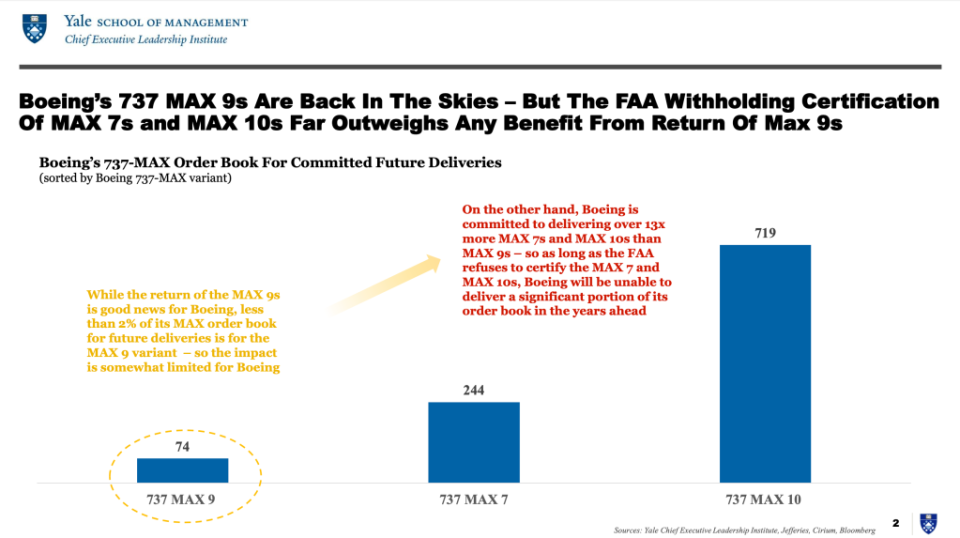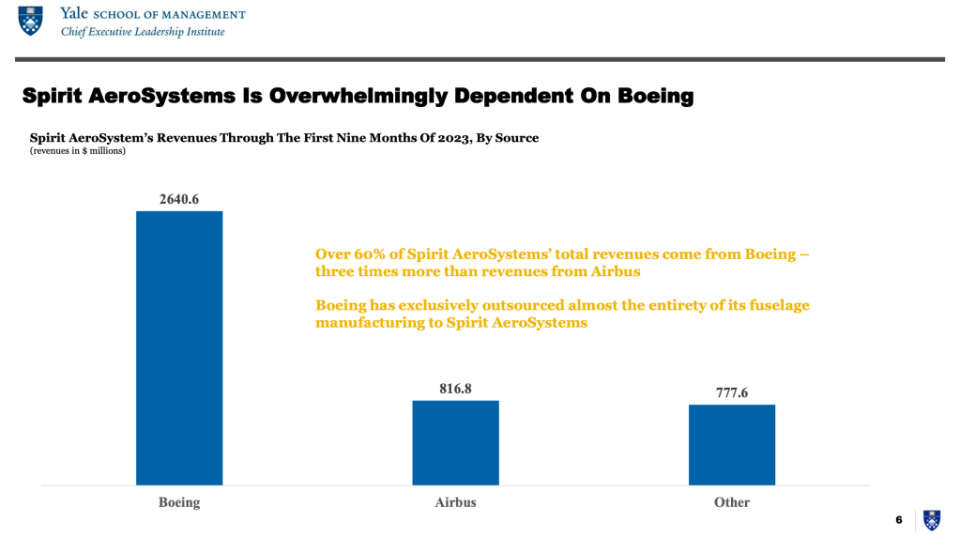Boeing CEO Dave Calhoun is on the hot seat. Here are 3 concrete steps he must take to restore the company’s credibility
Paradoxically, just as Boeing is getting its planes back in the air, its challenges are only getting more serious. The FAA’s announcement last week–that while Boeing’s grounded 737 MAX 9 jets are finally returning to the skies, there will be a complete halt on any production increases for the entire 737 MAX program and any new regulatory approvals for additional MAX lines, most notably the MAX 7 and 10, which were reportedly nearing FAA approval right before the Alaska Air accident earlier this month–suggests that regulators are running out of patience for Boeing’s persistent quality control woes and are putting the foot down this time, demanding systemic fixes. Meanwhile, Boeing’s airline customers are in open revolt: United’s CEO Scott Kirby has already begun talks with Airbus about substituting A321 purchases for their formerly planned new 277 Boeing 737 Max 10 purchases.
We’ve often praised Boeing CEO Dave Calhoun for navigating deftly through a slew of inherited challenges, including guiding Boeing back to cash flow profitability out of COVID and the aerospace cyclical downturn, repairing damaged relations with regulators, restarting deliveries to China, and reducing high indebtedness–but we also presciently predicted last year that quality control flare-ups would prove persistent.

With the FAA putting Boeing on probation, and by extension, Calhoun on the hot seat, restoring Boeing’s credibility has become the embattled CEO’s single most important and urgent mandate. Having known the last six CEOs of Boeing personally going back three decades, and having closely observed Boeing through many life stages even before the McDonnell Douglas merger, here are three concrete steps Calhoun should take to revive Boeing’s safety culture, along with an accompanying slide deck of original data supporting our recommendations.
1. Change governance and internal quality control processes to empower and embed safety more deeply across the organization
After the devastating 2019 MAX crashes that resulted in 376 deaths, the Boeing board established heightened safety processes, including a special five-person Aerospace Safety Subcommittee of the Board, as well as a Chief Aerospace Safety Officer within the company. Although four of the five members of the Safety Subcommittee are new board members with less than two years of experience (which is hardly surprising considering that 80% of Boeing’s board has turned over since 2019), their credentials are undoubtedly sterling, drawing across extensive aerospace sector experience. These include Subcommittee Chair and former CEO of GE Aviation David Joyce, former head of the U.S. Navy Adm. John Richardson, former CEO of Continental Airlines Lawrence Kellner, former Inspector General of the Air Force Gen. Stayce Harris, and Carrier Global CEO David Gitlin.

Yet the continued flare-up of safety issues means that something is evidently getting lost in translation between the board and the manufacturing and assembly lines–and the challenge runs much deeper than any single incident. How deeply the new quality control processes have permeated into Boeing’s production plants is an open question. One wonders whether safety-focused voices are sufficiently empowered internally, as one whistleblower report claimed that Boeing’s own quality control systems were routinely ignored with under-pressure line inspectors sometimes providing false or erroneous information, which would be consistent with long-running complaints of underinvestment and inadequate self-policing.
Calhoun’s appointment of an external safety expert to review Boeing’s safety processes is a step in the right direction–but the FAA appears to be pushing for more wholesale and permanent changes, including embedding FAA or third-party monitors directly across Boeing’s supply chain, unsatisfied with mere auditing.
2. Clean up Boeing’s broken supply chain
By all appearances, Boeing has lost functional oversight and control over its suppliers, an issue that has been exacerbated by a lack of supply chain diversification and accountability. This is embodied by Boeing’s dysfunctional relationship with Spirit AeroSystems, which manufactures virtually all of Boeing’s fuselages.
For years, we have presciently and repeatedly warned about the latent risk posed by Spirit to Boeing’s operations, as the “soft underbelly” in the supply chain, and how former CEO Harry Stonecipher made a mistake by selling Spirit in 2005–but new whistleblower reports suggest that this dysfunctional marriage may be even worse than we appreciated.
According to a fresh report in the Seattle Times this week, citing an anonymous but credible whistleblower, Boeing engineers found no less than 392 instances of Spirit quality control failures over the last year. In one instance, Spirit’s engineers supposedly repaired the issues, only for the Boeing inspector to discover that Spirit merely “painted over” the problematic parts, forcing Boeing to do any further repairs in-house. Additional reports document how Spirit employees were encouraged not to report problems amidst a culture of fear, intimidation, and cost-cutting, with expert veteran engineers replaced by legions of cheaper and undertrained replacements. Boeing has refused to respond to media requests for comment, citing ongoing investigations. Meanwhile, Spirit has issued a statement saying that their primary focus is “the quality and product integrity of the aircraft structures” they deliver, adding that the company was working with Boeing on the matter and following regulators’ protocols.
Although the Spirit leadership ranks have almost completely turned over in the last four months amidst apparent pressure, and even if accomplished new CEO Pat Shanahan is committed to fixing Spirit’s process challenges, the last 20 years have shown that Spirit should not be a standalone company, period. No matter how much Boeing’s financial whiz kids resist the prospect of diluting Boeing’s prized free cash flow with Spirit’s low-margin, capital-intensive business, and wobbly balance sheet, one has to wonder whether a sum equivalent to 3% of Boeing’s market capitalization is worth all the operational headaches, especially as Boeing continues to inject hundreds of millions into Spirit to keep it afloat.

The silver lining here for Boeing is that almost all of its suppliers are heavily dependent on Boeing and thus, all are aligned and motivated to urgently fix these underlying, long-deferred structural challenges together. As the old Churchill saying goes, “Never let a good crisis go to waste.”
3. Fortify public trust instead of deferring to regulators in communicating with the public
So far, Calhoun has won plaudits for his reassuring media interviews, all-staff meetings where he spoke about safety in personal terms as a father and grandfather, and desperately needed meetings with Congress in the days after the Alaska Air incident. Similarly, Calhoun was praised for letting his airline customers send inspectors to any Boeing or Spirit manufacturing plant in response to the public condemnations of major customers such as the CEOs of Hawaiian, United, and Ryanair.
But getting the MAX 9s back into the sky may have been the easy part. As the FAA digs in for protracted, intrusive oversight into Boeing’s internal process challenges in the months ahead, it will become progressively harder for Calhoun to control the narrative and continue fortifying public trust.
When Boeing faced similarly protracted regulatory reviews before, some of Calhoun's predecessors of were ill-advised to hide behind exceedingly vague, impersonal legalese in deference to regulators and investigators–which did not end well. This time around, Boeing’s challenge is even more acute since there will almost certainly need to be difficult but necessary tradeoffs in the months ahead. For example, even though Boeing has said repeatedly that building and delivering more MAXs is their top priority this year, many analysts consider it likely that Boeing will need to lower the lofty production and financial targets laid out merely months ago, and will likely need to withhold guidance during its highly anticipated earnings call on Wednesday. Some have also floated the prospect of internal reorganizations as accountability beckons.
Now more than ever, Justice Louis Brandeis’ quip that “sunlight is the best disinfectant” rings true. Public safety and fortifying public trust must outweigh all short-term commercial impacts, no matter what investors or lawyers say. Needless market panic, employee confusion, and sensationalized speculation can be avoided if tough but necessary moves are packaged and perceived as a part of a broader strategic plan to restore Boeing’s credibility, rather than being seen as reactionary impulsiveness or palace intrigue.
Furthermore, showing an accountable human face of leadership–rather than hiding behind bureaucratic processes or delegating bad news to subordinates–can go a long way in making bad news more palatable.
Many airline executives are now joking that the old mantra, “if it’s not Boeing, I’m not going” will be at risk of turning into “if it’s Boeing, it’s not going” unless Boeing can revive its safety culture soon. Where Boeing goes from here will largely depend on whether they are seen as having safe planes in the clouds–or whether they are seen as having their own heads in the clouds.
Jeffrey Sonnenfeld is the Lester Crown Professor in Management Practice and Senior Associate Dean at Yale School of Management. He was named “Management Professor of the Year” by Poets & Quants magazine.
Steven Tian is the director of research at the Yale Chief Executive Leadership Institute and a former quantitative investment analyst with the Rockefeller Family Office.
More must-read commentary published by Fortune:
Economic pessimists’ bet on a 2023 recession failed. Why are they doubling down in 2024?
‘Parroting Putin’s propaganda’: The business exodus over Ukraine was no Russian bonanza
WEF president: ‘It’s time to revitalize trade—and reverse the trend of Slowbalization’
The anti-DEI movement has gone from fringe to mainstream. Here’s what that means for corporate America
The opinions expressed in Fortune.com commentary pieces are solely the views of their authors and do not necessarily reflect the opinions and beliefs of Fortune.
This story was originally featured on Fortune.com

 Yahoo Finance
Yahoo Finance 